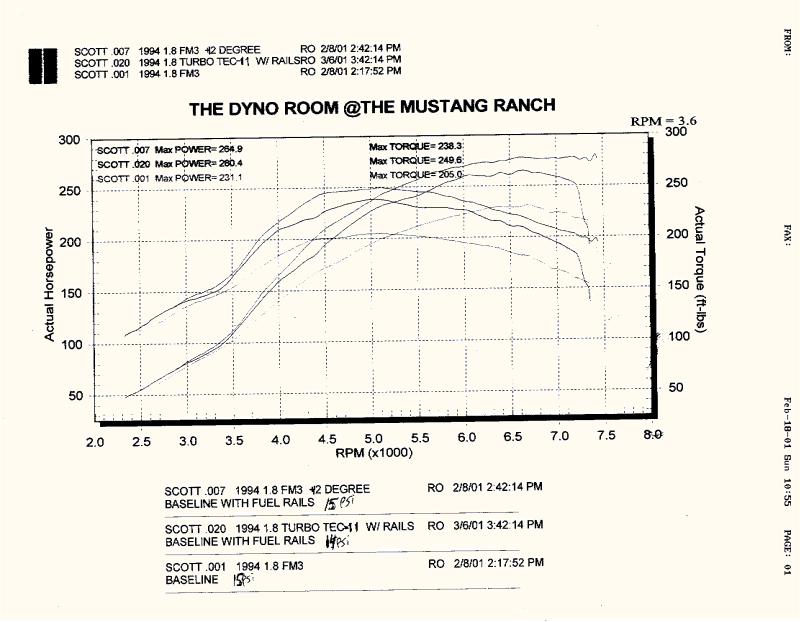Jason's website | home
My software dyno | Initial dyno results of TEC-II, NA, then turbo | 1.6 and "95hp" NA tuning | my former Greddy setup | DIY 2001 braces | fuelling circuit for M1's | AVO turbo install | Shiv's fuel rail yields 265 hp | 280hp dyno tuning by Shiv on Scott's 1.8
280hp dyno tuning by Shiv on Scott's 1.8
(265 hp from fuel rail install here)
As posted by Shiv on the powerlist:
-------------------------------------------------
Title: Max Power Dyno tuning... the good and the bad
Scott MacLean and I just got back from the Dyno Room (Santa Clara, CA) where we dyno tuned his car (now with the TEC-II that we installed a couple nights ago). With the TEC-II and my dual-feed fuel rails, Scott's bone stock, never-been-opened, 100k mile '94 junkyard engine was tuned to make an uncorrected (as measured) 220rwhp at 8psi. After a few more runs, it made 240 rwhp at 10psi. Several runs later, now running 13-14psi of boost, it made a record-setting 280.4rwhp. Approx 250ft-lbs of torque between 4500 and 5500rpm. Torque falls off to 210ft-lbs by 7000rpm. This is nearly **60 horsepower** more than it made a couple months ago, running 15psi with the stock fuel rails and Link ECU. 'Wow," we thought, "let's keep it going." Up until then, each consecutive run and tuning tweak, yielded better and better dyno results. Scott's smile kept getting wider. My cajones kept on getting bigger. Terry's eyes kept on getting rounder.
With fifteen consecutive and completely event-free 250-280rwhp dyno runs under our belts (in a span of just 40 minutes), we were curious to see what the car could make at a full 15psi. Would the car come close to 300rwhp? Would it surpass my old turbo car, which ran a ported head and race gas?
Only one way to find out.
And we're off. Everything was absolutely perfect up to 5500rpm. The car was making gobs of torque and was sounding strong as heck. When, all of a sudden, the motor called it quits. No knock. No boom. No terrible clunking noises. Clutch in. Engine off. Inspect. A squashed spark plug electrode indicated a serious mechanical failure in cylinder 4. Perhaps a snapped rod, shattered piston or broken wrist pin. Can't tell for sure until we open it up. Fortunately, Scott has another junkyard-sourced long block sitting in his garage that we can either install or build-up in the meantime. But judging by the way the engine failed, logic would dictate the stronger pistons and rods are in order if more power is to be achieved. A little head work would surely help as well. Either way, we'll be back in fighting trim.
But why the failure? Without ever hearing or seeing any signs of detonation (on the plugs, from the dyno, or with the ears) Terry and I both have a strong suspicion that the failure was simply output related. The engine torque may have been simply too much for the internals to handle after repeated dyno runs. I sure hope that's the case as I tried hard to keep a big safety margin against detonation and lean-run. As far as I know, this humble $500 junkyard motor was making more power, albeit for a short period of time, than any other pump gas-sipping bone stock motor in turbo Miata history. Nearly 50 more wheel hp than the highest powered turbo Miata at the last FM Open House dyno day. Nearly 30 more wheel hp than any turbo Miata at any Cyno De Mayo dyno event. All this while running just under 14psi on 92 octane CA gas (now with MTBE). Not much consolation but still impressive nonetheless.
That's it for now. Both Terry, Scott and I are very eager to see what component failed. When determined, I'll post up pics.
That's it for now...
Sadly,
Shiv
---------------------------------
Here are the dyno plots
Baseline is FM3 (15 psi)
Higher up is FM3 with fuel rail and added timing (15 psi)
Highest is with TEC-II in place of Link ECU, plus tuning (14 psi)
